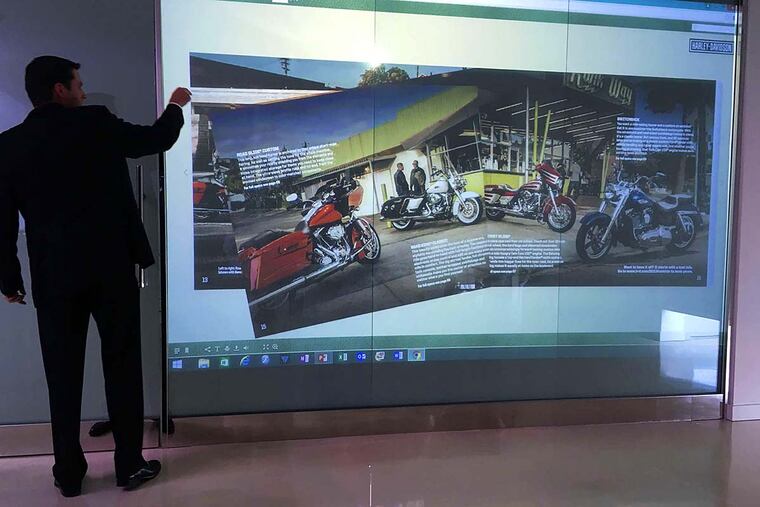Gizmo Guy: Solar-powered house, from TV to garden
When the next "War of the Worlds" disaster sends us all careening out of town, I know where I'm going to hide out: Bensalem.

When the next "War of the Worlds" disaster sends us all careening out of town, I know where I'm going to hide out: Bensalem.
More precisely, heading north on I-95 to a WWII-era industrial park on State Road and an unexpected new tech showroom that goes by the clunky name ISPBC (International Self Powered-Business Council) PHL Showcase.
Although glass-walled and -roofed, this is a house you can throw stones at. It's built largely of multilayered, "hurricane resistant" photovoltaic windows, a super solar glass that takes a beating and soaks up enough energy to make the 1,100 square-foot building self-powered.
"We're generating and storing 12,000 kilowatt hours of electricity a year," said project developer Michael Holbert inside the eco-smart and well-cooled environs. "If this building was an embassy under siege, and somebody tried to take out your power grid, you'd still be safe and able to run things." (No, the glass is not bulletproof, but "just a step under that.")
Even the counter and desk tops inside the structure are energy harvesting. And are coated - as are all internal surfaces and the air handling system - with a formulation called XTi360: 99 percent water and 1 percent titanium dioxide (TiO2) nanoparticles. The product, which Holbert sells as "Clean Coating," performs a "photo-catalytic conversion, breaking down germs and odors on contact." How safe is it? TiO2 is FDA-approved, and is also found in "chewing gum, sunscreen, toothpaste and sour bears," Holbert said.
Right, then. But what will we eat while stuck in there? "Food production is another one of the five pillars of the International Self-Powered Building Council that we're showing here," assured my tour guide, who also serves in his spare time as director of the Philadelphia ISPBC steering community.
In a wink, a Holbert colleague was serving up a frothy, veggie-and-fruit drink with ingredients largely grown indoors in their glass-walled, LED-lit hydroponic garden. Greens such as kale and spinach thrive in the ultra-clean space.
And how will we save ourselves from going stir-crazy in this safe house? For that, Holbert flipped a couple switches and converted a 165-inch diagonally measured glass wall into a high-definition interactive TV screen fitted with touch-control technology. It's akin to those huge, hands-on TV walls that CNN political analysts love to toy with on election night and that jazzed up the movie action in Iron Man.
One minute, the wall screen was playing a movie, the next, providing a Google Map with hands-on zooming in to my work 'hood. Then my host flipped through the pages of an on-screen catalog, bringing new meaning to the term "window shopping."
Like other ISPBC stuff, the video display is glass-based, with a special liquid-crystal backing film "applied like tinting" on car windows to catch the light of a high-output NEC laser projector. And the screen's "secret sauce" for touch control, built into a signal-beaming frame, was sourced, like most of the room's attractions, in Taiwan, the world's "semiconductor capital," Holbert said.
Just as the solar panels he imports can be used to "re-skin" an existing building, the interactive video walls produced by Holbert's Smart Retail User Interface L.L.C. can be retrofitted to existing spaces such as office meeting rooms and the windows of retail shops. Fabrication of these is done in a factory just behind the ISPBC showroom - one reason the proprietor set up shop here, along with the location's "easy access" to highways, planes and trains.
Showing his roots - his family founded (and he used to toil at) Holbert Porsche-Audi-VW - the touch screen uber-displays can be paid for over a four- or five-year span, "which brings down the price of a typical 6 foot by 9 foot panel, installed, to $750 a month."
Long-term financing is not an option that other screen wall fabricators offer, noted Josh Goldblum, CEO of Fishtown-based Bluecadet, a major player in museum exhibit design and construction. But he discounted Holbert's claim that his 165-inch showroom sample (which sells for $30,000) is the "largest high-definition interactive media window." Bluecadet just "installed a 20-foot-by-30-foot user-controllable touch screen at the Smithsonian's National Air and Space Museum."
Bensalem Mayor Joseph DiGirolamo is pleased by Holbert's product showroom (open only by appointment). "To me, it's the future. And it's available today."
Seconding the emotion, Bensalem building and planning director Matt Takita sees the demo space and factory as key to the town's 675-acre riverfront redevelopment and a 100-acre zone offering financial incentives to attract "advanced manufacturing and clean technology, incubators and start-ups."
215-854-5960
@JTakiff